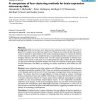Free Online Productivity Tools
i2Speak
i2Symbol
i2OCR
iTex2Img
iWeb2Print
iWeb2Shot
i2Type
iPdf2Split
iPdf2Merge
i2Bopomofo
i2Arabic
i2Style
i2Image
i2PDF
iLatex2Rtf
Sci2ools
BMCBI
2008
2008
A comparison of four clustering methods for brain expression microarray data
Background: DNA microarrays, which determine the expression levels of tens of thousands of genes from a sample, are an important research tool. However, the volume of data they produce can be an obstacle to interpretation of the results. Clustering the genes on the basis of similarity of their expression profiles can simplify the data, and potentially provides an important source of biological inference, but these methods have not been tested systematically on datasets from complex human tissues. In this paper, four clustering methods, CRC, k-means, ISA and memISA, are used upon three brain expression datasets. The results are compared on speed, gene coverage and GO enrichment. The effects of combining the clusters produced by each method are also assessed. Results: k-means outperforms the other methods, with 100% gene coverage and GO enrichments only slightly exceeded by memISA and ISA. Those two methods produce greater GO enrichments on the datasets used, but at the cost of much low...
| Added | 09 Dec 2010 |
| Updated | 09 Dec 2010 |
| Type | Journal |
| Year | 2008 |
| Where | BMCBI |
| Authors | Alexander L. Richards, Peter Holmans, Michael C. O'Donovan, Michael J. Owen, Lesley Jones |
Comments (0)

